MITSUBISHI ECLIPSE 1990 Service Manual
Manufacturer: MITSUBISHI, Model Year: 1990, Model line: ECLIPSE, Model: MITSUBISHI ECLIPSE 1990Pages: 391, PDF Size: 15.27 MB
Page 231 of 391
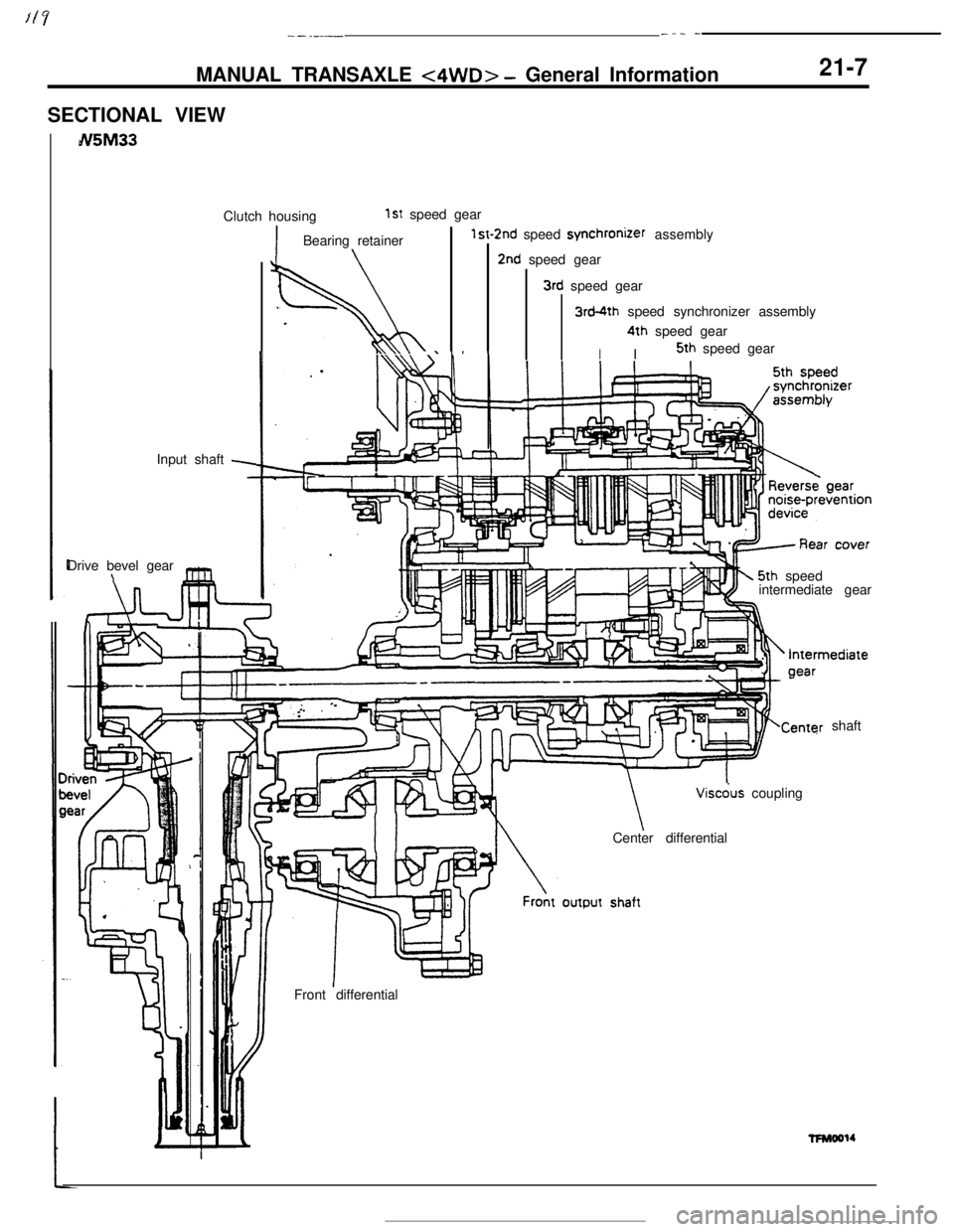
--.-.--_ _ _-MANUAL TRANSAXLE
<4WD> - General Information
SECTIONAL VIEWN5M3321-7Clutch housing
1st speed gear
Input shaft
-Drive bevel gear
\r
l!
.IBearing retainer\
St-1
w
.
I,..\\I \ I I
2nd speed synchronizer assembly
2nd speed gear
3rd speed gear
3rd-4th speed synchronizer assembly
I4th speed gear
I5th speed gear
5th speed
intermediate gear
shaft
Center differential
Front differentialViscdus coupling
wMool4
Page 232 of 391
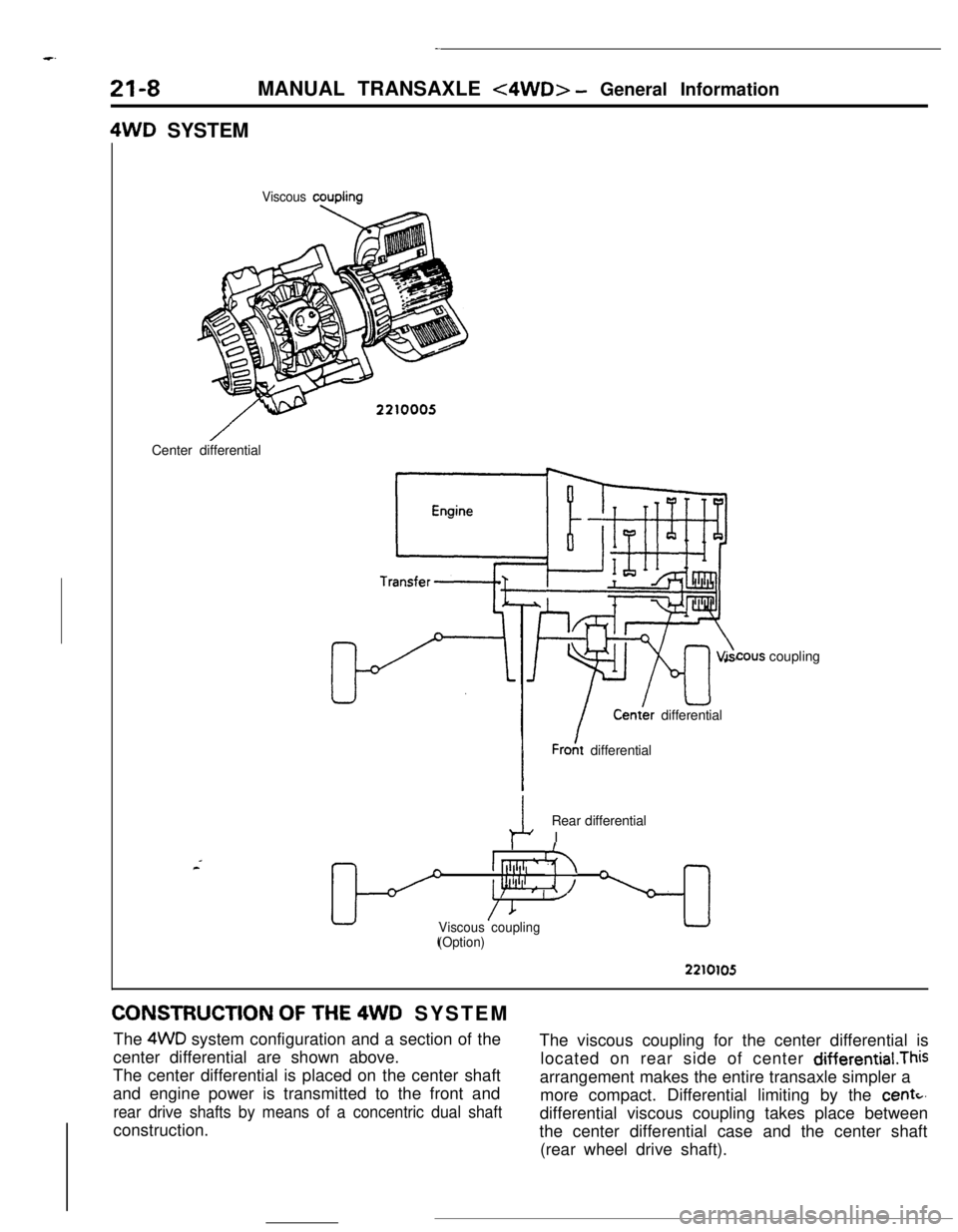
_.c.
21-8MANUAL TRANSAXLE <4WD> - General Information4WD SYSTEM
Viscous couplingCenter differential
cous coupling
kCenth differential
I
IFro& differential
Rear differential
I
I
I [[lll,i, ‘- h-
1 p’f’ ,* , l/i\
/IViscous couplingL
(Option)
3
2210105CONSTRUCTION
OF THE 4WD SYSTEM
The 4WD system configuration and a section of the
center differential are shown above.The viscous coupling for the center differential is
The center differential is placed on the center shaftlocated on rear side of center differential.This
and engine power is transmitted to the front andarrangement makes the entire transaxle simpler a
rear drive shafts by means of a concentric dual shaftmore compact. Differential limiting by the
centc,construction.differential viscous coupling takes place between
the center differential case and the center shaft
(rear wheel drive shaft).
Page 233 of 391
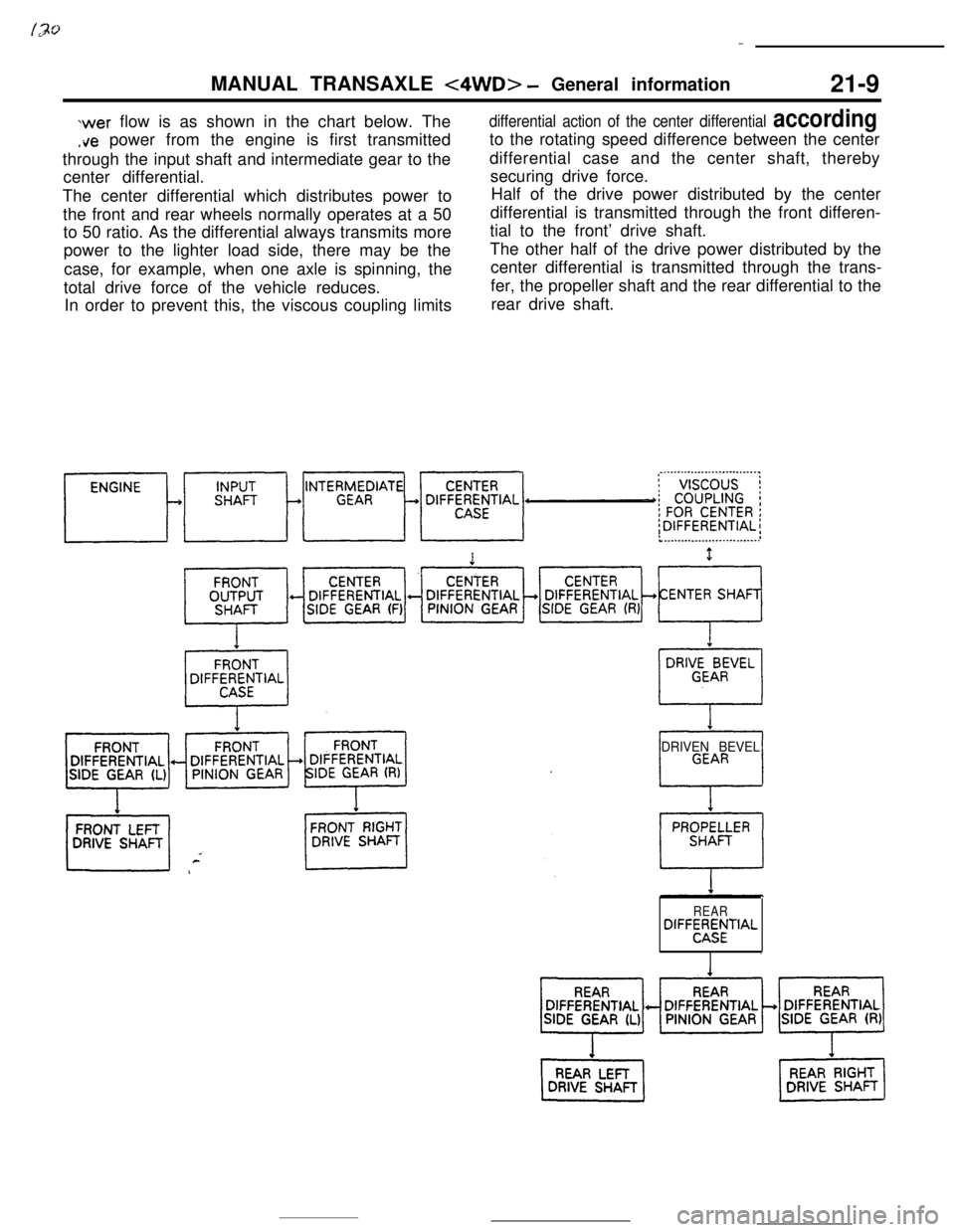
-MANUAL TRANSAXLE
<4WD> - General information
21-9
wer flow is as shown in the chart below. The
.ire power from the engine is first transmitted
through the input shaft and intermediate gear to the
center differential.
The center differential which distributes power to
the front and rear wheels normally operates at a 50
to 50 ratio. As the differential always transmits more
power to the lighter load side, there may be the
case, for example, when one axle is spinning, the
total drive force of the vehicle reduces.
In order to prevent this, the viscous coupling limits
differential action of the center differential accordingto the rotating speed difference between the center
differential case and the center shaft, thereby
securing drive force.
Half of the drive power distributed by the center
differential is transmitted through the front differen-
tial to the front’ drive shaft.
The other half of the drive power distributed by the
center differential is transmitted through the trans-
fer, the propeller shaft and the rear differential to the
rear drive shaft.
DRIVEN BEVEL
REARDIFF~;MfTIAL
,
Page 234 of 391
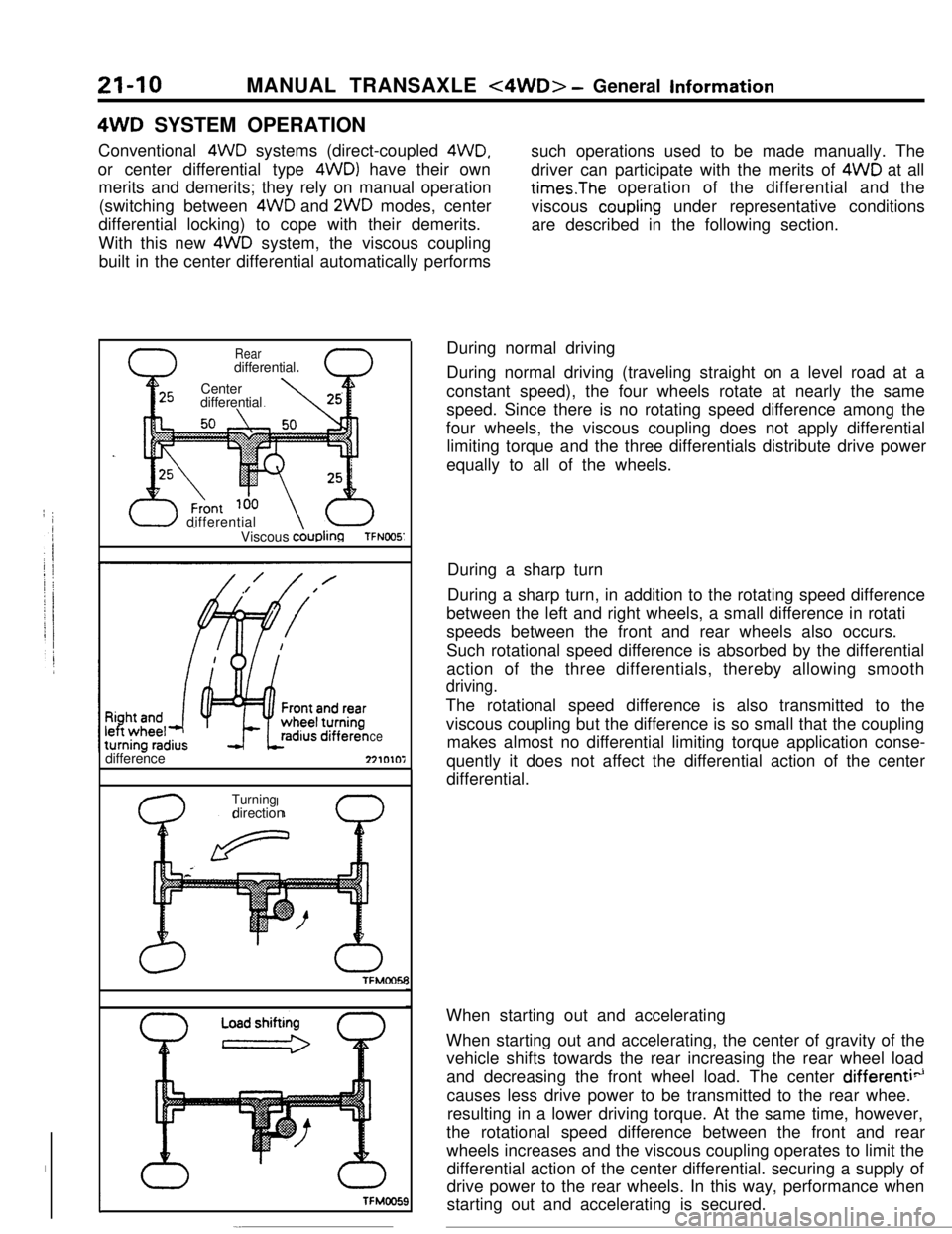
21-10MANUAL TRANSAXLE <4WD> - General Information4WD SYSTEM OPERATION
Conventional 4WD systems (direct-coupled
4WD,or center differential type 4WDl have their own
merits and demerits; they rely on manual operation
(switching between 4WD and 2WD modes, center
differential locking) to cope with their demerits.
With this new 4WD system, the viscous coupling
built in the center differential automatically performssuch operations used to be made manually. The
driver can participate with the merits of 4WD at alltimes.The operation of the differential and the
viscous
coupling under representative conditions
are described in the following section.
I
Reardifferential
Center
differential
U differential
Viscous AuDk?TFNOO5’difference
ce271010i
TFMMYTFMMY
0
Turningdirection
ITFMOO!X
-.During normal driving
During normal driving (traveling straight on a level road at a
constant speed), the four wheels rotate at nearly the same
speed. Since there is no rotating speed difference among the
four wheels, the viscous coupling does not apply differential
limiting torque and the three differentials distribute drive power
equally to all of the wheels.
During a sharp turn
During a sharp turn, in addition to the rotating speed difference
between the left and right wheels, a small difference in rotati
speeds between the front and rear wheels also occurs.
Such rotational speed difference is absorbed by the differential
action of the three differentials, thereby allowing smooth
driving.The rotational speed difference is also transmitted to the
viscous coupling but the difference is so small that the coupling
makes almost no differential limiting torque application conse-
quently it does not affect the differential action of the center
differential.
When starting out and accelerating
When starting out and accelerating, the center of gravity of the
vehicle shifts towards the rear increasing the rear wheel load
and decreasing the front wheel load. The center
differenti”causes less drive power to be transmitted to the rear whee.
resulting in a lower driving torque. At the same time, however,
the rotational speed difference between the front and rear
wheels increases and the viscous coupling operates to limit the
differential action of the center differential. securing a supply of
drive power to the rear wheels. In this way, performance when
starting out and accelerating is secured.
Page 235 of 391
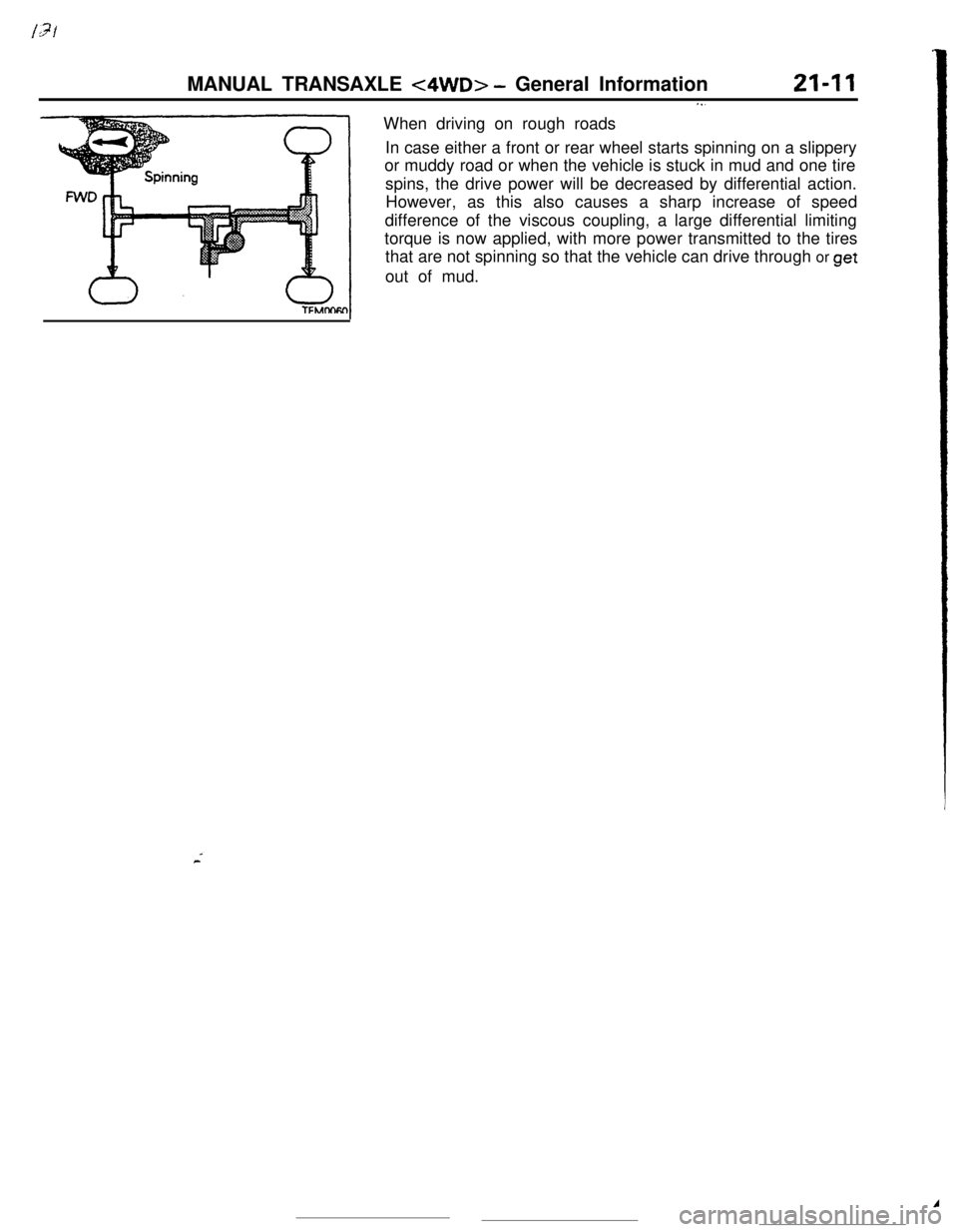
MANUAL TRANSAXLE <4WD> - General Information21-I 1When driving on rough roads. . .In case either a front or rear wheel starts spinning on a slippery
or muddy road or when the vehicle is stuck in mud and one tire
spins, the drive power will be decreased by differential action.
However, as this also causes a sharp increase of speed
difference of the viscous coupling, a large differential limiting
torque is now applied, with more power transmitted to the tires
that are not spinning so that the vehicle can drive through or
getout of mud.A
Page 236 of 391
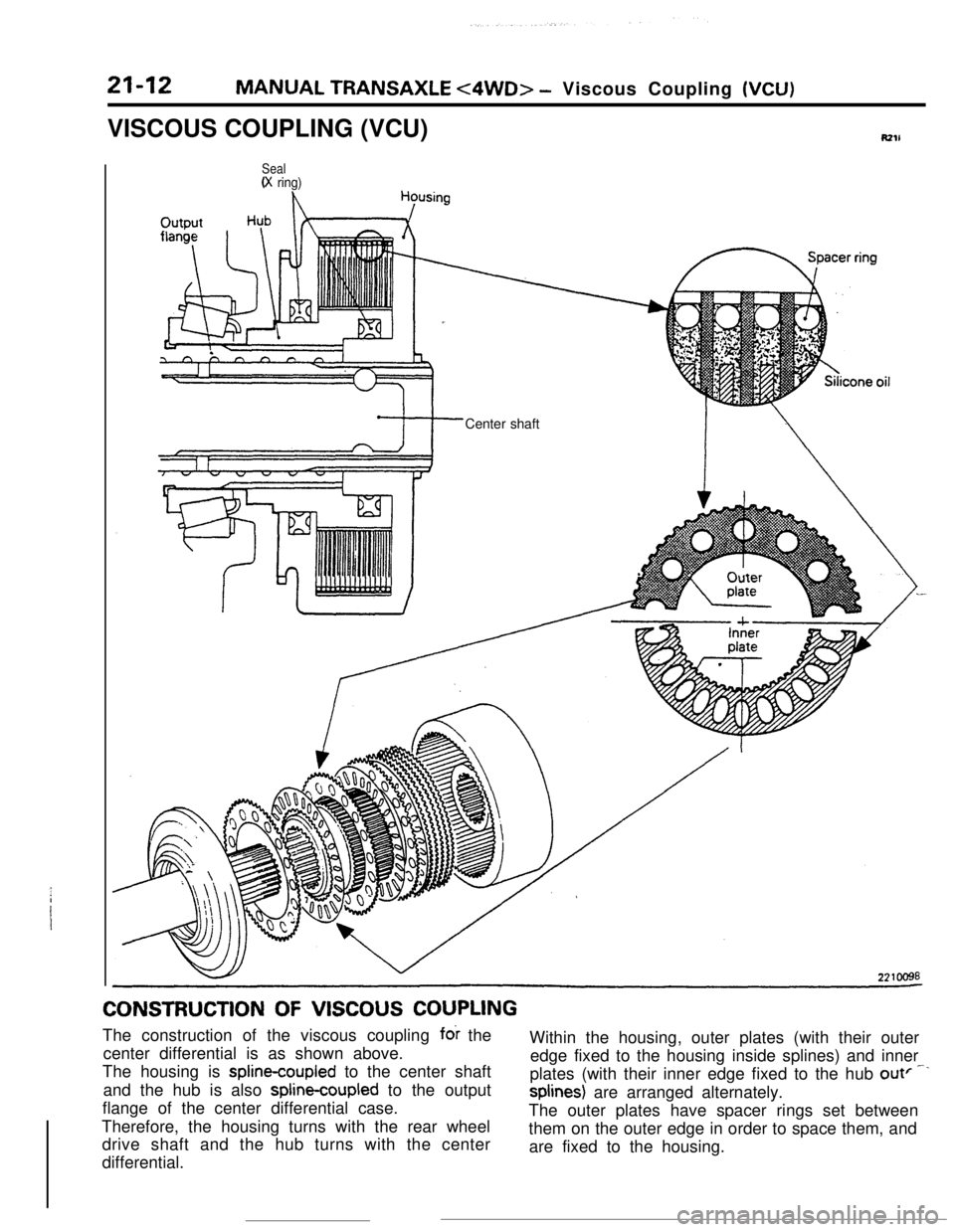
21-12MANUAL TRANSAXLE <4WD> - Viscous Coupling (VCU)
VISCOUS COUPLING (VCU)
RZlL
Seal(X ring)Center shaftCONSTRUCTION
OF VISCOUS COUPLINGThe construction of the viscous coupling
fck the
Within the housing, outer plates (with their outer
center differential is as shown above.
edge fixed to the housing inside splines) and inner
The housing is splinecoupled to the center shaft
plates (with their inner edge fixed to the hub
outF--and the hub is also
spline-coupled to the outputsplines) are arranged alternately.
flange of the center differential case.
The outer plates have spacer rings set between
Therefore, the housing turns with the rear wheel
them on the outer edge in order to space them, and
drive shaft and the hub turns with the center
are fixed to the housing.
differential.
Page 237 of 391
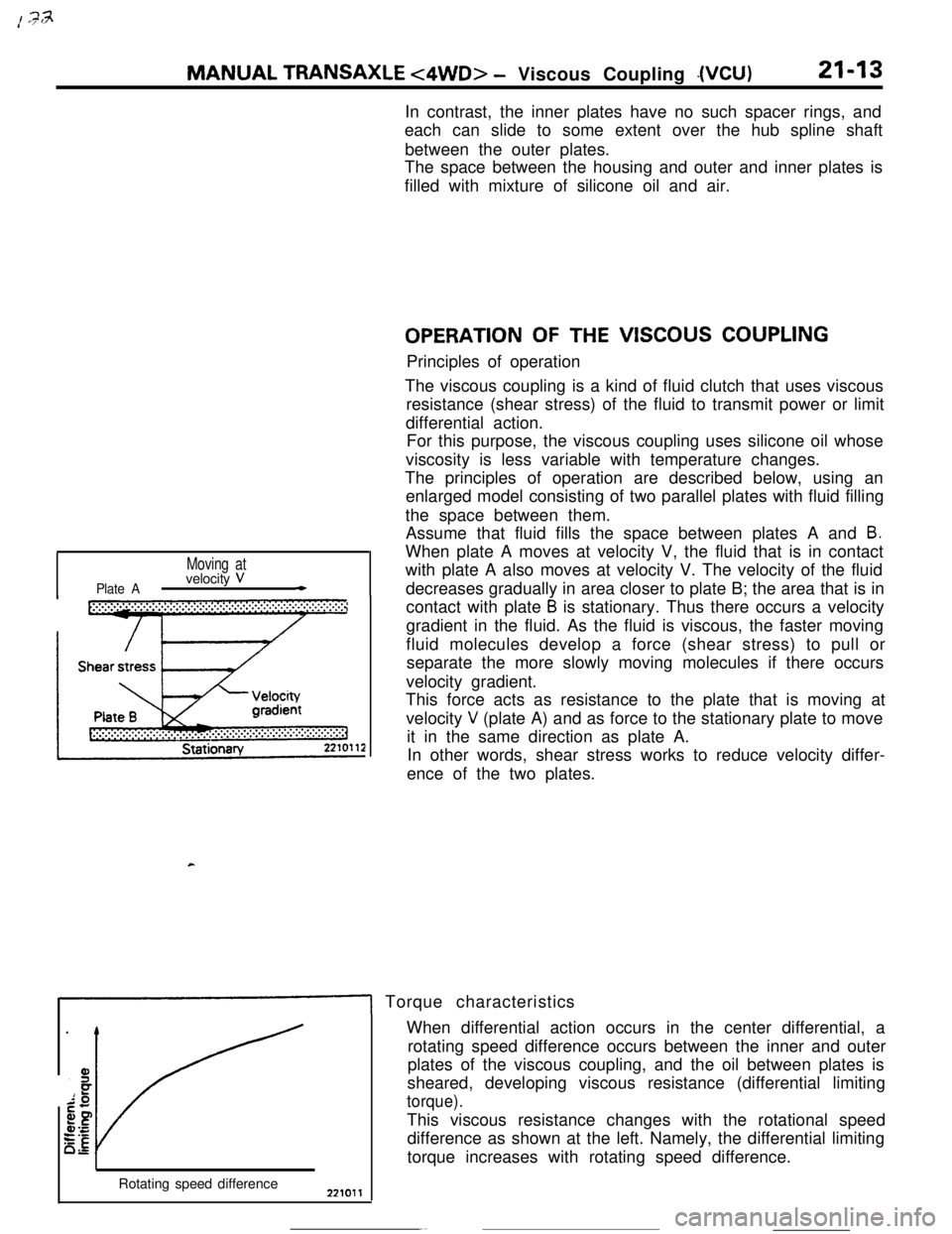
MANUAL TRANSAXLE <4WD> - Viscous Coupling .(VClJ)21-13In contrast, the inner plates have no such spacer rings, and
each can slide to some extent over the hub spline shaft
between the outer plates.
The space between the housing and outer and inner plates is
filled with mixture of silicone oil and air.
Plate A
Moving atvelocity V*
OPERATION OF THE VISCOUS COUPLINGPrinciples of operation
The viscous coupling is a kind of fluid clutch that uses viscous
resistance (shear stress) of the fluid to transmit power or limit
differential action.
For this purpose, the viscous coupling uses silicone oil whose
viscosity is less variable with temperature changes.
The principles of operation are described below, using an
enlarged model consisting of two parallel plates with fluid filling
the space between them.
Assume that fluid fills the space between plates A and
B.When plate A moves at velocity V, the fluid that is in contact
with plate A also moves at velocity V. The velocity of the fluid
decreases gradually in area closer to plate B; the area that is in
contact with plate
B is stationary. Thus there occurs a velocity
gradient in the fluid. As the fluid is viscous, the faster moving
fluid molecules develop a force (shear stress) to pull or
separate the more slowly moving molecules if there occurs
velocity gradient.
This force acts as resistance to the plate that is moving at
velocity
V (plate A) and as force to the stationary plate to move
it in the same direction as plate A.
In other words, shear stress works to reduce velocity differ-
ence of the two plates.
1 Torque characteristics
Rotating speed differenceWhen differential action occurs in the center differential, a
rotating speed difference occurs between the inner and outer
plates of the viscous coupling, and the oil between plates is
sheared, developing viscous resistance (differential limiting
torque).This viscous resistance changes with the rotational speed
difference as shown at the left. Namely, the differential limiting
torque increases with rotating speed difference.
Page 238 of 391
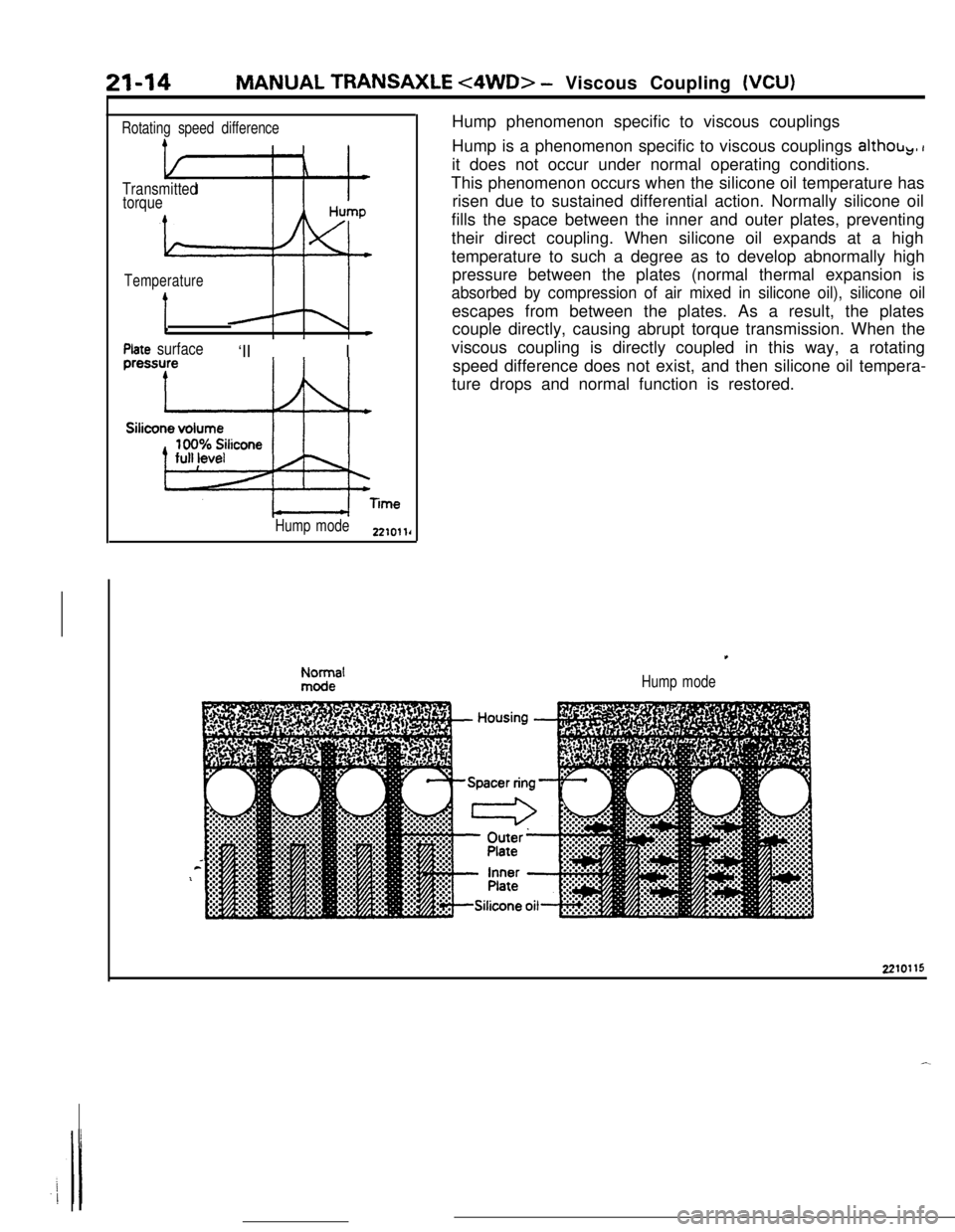
21-14MANUAL TRANSAXLE t4WD> - Viscous Coupling (VCU)
Rotating speed difference
Transmitted
torque
TemperatureII I
t
/
IIc
P&e surface‘II I
preTYl-LLL
Hump mode2210llrHump phenomenon specific to viscous couplings
Hump is a phenomenon specific to viscous couplings
althob,, Iit does not occur under normal operating conditions.
This phenomenon occurs when the silicone oil temperature has
risen due to sustained differential action. Normally silicone oil
fills the space between the inner and outer plates, preventing
their direct coupling. When silicone oil expands at a high
temperature to such a degree as to develop abnormally high
pressure between the plates (normal thermal expansion is
absorbed by compression of air mixed in silicone oil), silicone oilescapes from between the plates. As a result, the plates
couple directly, causing abrupt torque transmission. When the
viscous coupling is directly coupled in this way, a rotating
speed difference does not exist, and then silicone oil tempera-
ture drops and normal function is restored.
Hump mode2210115
Page 239 of 391

MANUAL TRANSAXLE <4WD> - Transaxle Control
TRANSAXLE CONTROL,
4~ construction and operation, refer to TRANSAX-LE CONTROL of 2WD system.
21-15
RZlCMB
Page 240 of 391
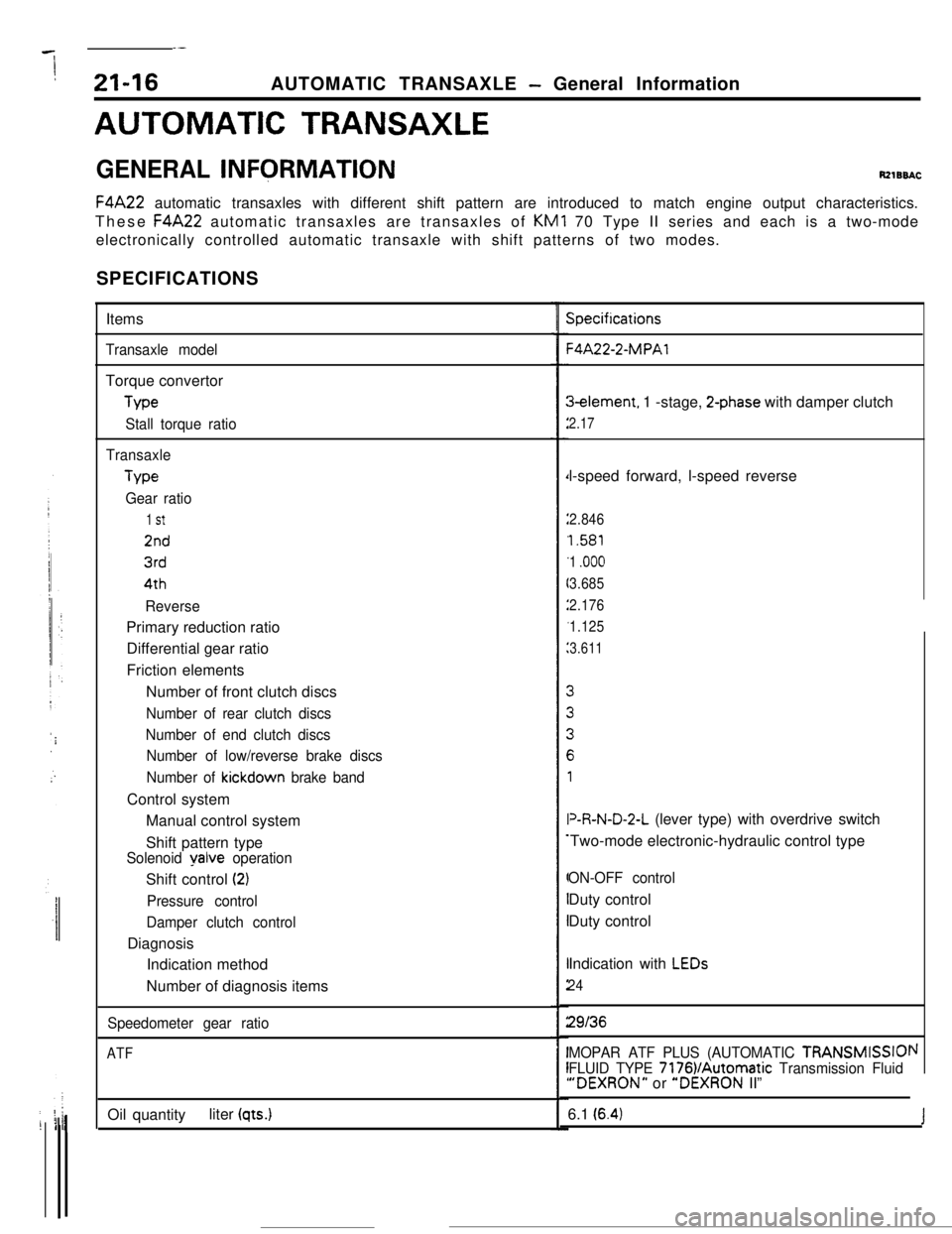
_-
21-16AUTOMATIC TRANSAXLE - General InformationAUTOMATIC
TRANSAXLE
GENERAL INFQRMATIONRzlBBACF4A22 automatic transaxles with different shift pattern are introduced to match engine output characteristics.
These F4A22 automatic transaxles are transaxles of KM1 70 Type II series and each is a two-mode
electronically controlled automatic transaxle with shift patterns of two modes.
SPECIFICATIONS
Items
Transaxle modelTorque convertor
Me
Stall torque ratio
TransaxleType
Gear ratio
1 St
2nd
3rd4th
ReversePrimary reduction ratio
Differential gear ratio
Friction elements
Number of front clutch discs
Number of rear clutch discs
Number of end clutch discs
Number of low/reverse brake discs
Number of
kickdown brake bandControl system
Manual control system
Shift pattern type
Solenoid yalve operationShift control
(2)
Pressure control
Damper clutch controlDiagnosis
Indication method
Number of diagnosis items
Speedometer gear ratio
ATFOil quantityliter
(qts.)
Specifications-4A22-2-MPAl3element, 1 -stage,
2-phase with damper clutch
2.17l-speed forward, l-speed reverse
2.846
1.581
1
.ooo
3.685
2.176
1.125
3.611V&N-D-2-L (lever type) with overdrive switch
Two-mode electronic-hydraulic control type
ON-OFF controlDuty control
Duty control
Indication with
LEDs
24
29136
MOPAR ATF PLUS (AUTOMATIC TRANSMISSIOI
FLUID TYPE 7176VAutomatic Transmission Fluid“DEXRON” or “DEXRON II”
\I6.1
(6.4)J